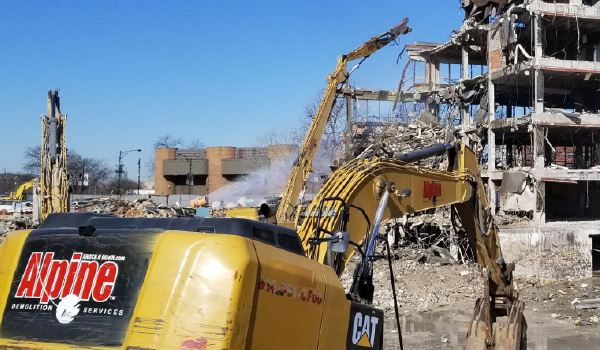Transforming Areas: Interior Demolition for Residential and Commercial Projects
Transforming Areas: Interior Demolition for Residential and Commercial Projects
Blog Article
The Ultimate Overview to Inside Demolition Techniques and Tools
Within the realm of interior restorations, the art of demolition is an essential stage that requires accuracy, skill, and the right collection of devices. Whether you are a seasoned professional or a DIY enthusiast, comprehending the complexities of interior demolition methods can make all the difference in accomplishing a successful task outcome.
Necessary Indoor Demolition Devices
When embarking on indoor demolition tasks, having the ideal tools is necessary for performance and security. One of the most important devices for interior demolition is the demolition hammer. This sturdy device is created to damage through difficult materials like tile, drywall, and concrete.
Another essential device is a reciprocating saw, which is ideal for reducing via a range of products such as plastic, wood, and metal. Its capability to make exact cuts in limited areas makes it ideal for demolition job. In addition, an energy blade is needed for cutting materials like carpet, vinyl floor covering, and insulation. Its sharp blade makes sure precise and clean cuts, promoting the elimination of unwanted materials. In general, having these crucial indoor demolition tools will considerably enhance the performance and safety and security of any kind of demolition job.

Security Safety Measures Throughout Demolition

Furthermore, all workers associated with the demolition procedure ought to receive ample training on the proper handling of devices and equipment to lessen accidents. It is vital to safeguard the job area by setting up obstacles and indicators to stop unauthorized accessibility - interior demolition. Consistently examining and keeping devices and tools can likewise add to a safer working atmosphere. By sticking to these security precautions, indoor demolition tasks can be executed successfully while focusing on the well-being of all people included.
Strategies for Getting Rid Of Walls
Executing correct safety precautions throughout indoor demolition tasks is crucial for creating a secure workplace, and one essential facet of such tasks involves understanding techniques for eliminating wall surfaces. One generally utilized method is manual demolition, which calls for the use of basic hand tools such as sledgehammers, crowbars, and utility knives to thoroughly dismantle the wall surface item by piece. This strategy permits for better control over the demolition process, particularly in delicate areas where precision is vital.
For bigger, more complicated walls, mechanical demolition might be essential. This involves making use of hefty equipment like excavators or excavators to tear down walls effectively. Nevertheless, it is vital to guarantee that the architectural integrity of the building is not endangered throughout mechanical demolition.
An additional method for removing wall surfaces is deconstruction, where the wall is dismantled in a method that preserves multiple-use products. This sustainable method is eco-friendly and can likewise aid reduce disposal expenses. Whichever technique is used, it is vital to adhere to appropriate safety and security procedures and consider the architectural effects of wall surface elimination to guarantee an effective indoor demolition project.
Removing Floor Covering Like a Pro
Successfully eliminating floor covering during interior demolition calls for the appropriate browse around here devices and methods to make sure a effective and smooth procedure. The primary step in eliminating floor covering is to get rid of the location of any type of furniture or challenges. Next, recognize the sort of floor covering to determine the suitable removal technique. For wood or laminate floor covering, begin by removing the walls and after that make use of a flooring scrape to lift and remove the planks. Rug removal involves cutting the carpet right into manageable sections and rolling it up for disposal. For ceramic tile or plastic flooring, a carve or flooring scrape can be utilized to pry up the floor tiles or sheets. It's vital to put on safety gear such as handwear covers, goggles, and a mask to avoid injuries and exposure to dirt and debris. In addition, having a dumpster or designated disposal area prepared for the eliminated flooring materials is important for preserving a tidy workplace. By following these techniques and making use of the right tools, eliminating flooring like a pro can be accomplished effectively and successfully.
Proper Waste Disposal Techniques
After successfully getting rid of flooring making use of the suitable devices and techniques, the next essential action in the indoor demolition process is carrying out appropriate waste disposal techniques. Proper waste disposal is necessary for preserving a tidy and risk-free work atmosphere throughout and after demolition.

Contractors must abide by regional guidelines read this post here regarding garbage disposal to avoid charges and fines. Using professional waste management solutions can enhance the disposal procedure and ensure conformity with environmental guidelines. By implementing appropriate waste disposal approaches, interior demolition projects can be completed efficiently and sustainably.
Conclusion
In final thought, indoor demolition calls for the use of vital tools and strict security preventative measures to make certain a risk-free and effective process. By following these standards, interior demolition can be finished effectively and with very little risks.
One of the most important tools for indoor demolition is the demolition hammer (interior i was reading this demolition). On the whole, having these important interior demolition devices will significantly enhance the performance and security of any demolition project
Efficiently getting rid of flooring during interior demolition requires the correct devices and methods to make certain a effective and smooth process.After effectively removing flooring making use of the proper tools and techniques, the following essential action in the indoor demolition procedure is applying correct waste disposal techniques.In verdict, indoor demolition needs the usage of important tools and stringent safety preventative measures to make certain a safe and successful procedure.
Report this page